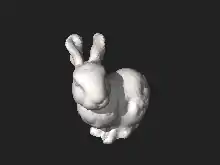Stanford bunny
The Stanford bunny is a computer graphics 3D test model developed by Greg Turk and Marc Levoy in 1994 at Stanford University. The model consists of 69,451 triangles, with the data determined by 3D scanning a ceramic figurine of a rabbit.[1] This figurine and others were scanned to test methods of range scanning physical objects.[2]


The data can be used to test various graphics algorithms, including polygonal simplification, compression, and surface smoothing. There are a few complications with this dataset that can occur in any 3D scan data: the model is manifold connected and has holes in the data, some due to scanning limits and some due to the object being hollow.[3] These complications provide a more realistic input for any algorithm that is benchmarked with the Stanford bunny,[4] though by today's standards, in terms of geometric complexity and triangle count, it is considered a simple model.
The model was originally available in .ply (polygons) file format with 4 different resolutions.
See also
References
- Riener, Robert; Harders, Matthias (2012-04-23). Virtual Reality in Medicine. Springer Science & Business Media. p. 55. ISBN 9781447140115.
- Turk, Greg; Levoy, Marc (1994-01-01). Zippered Polygon Meshes from Range Images. Proceedings of the 21st Annual Conference on Computer Graphics and Interactive Techniques. SIGGRAPH '94. New York, NY, USA: ACM. pp. 311–318. doi:10.1145/192161.192241. ISBN 978-0897916677.
- Turk, Mark (August 2000). "The Stanford Bunny". www.cc.gatech.edu. Retrieved 2016-04-06.
- Lindstrom, P.; Turk, G. (1998-10-01). Fast and memory efficient polygonal simplification. Visualization '98. Proceedings. pp. 279–286. CiteSeerX 10.1.1.452.5851. doi:10.1109/VISUAL.1998.745314. ISBN 978-0-8186-9176-8.
External links
| Wikimedia Commons has media related to Stanford bunny. |
- The Stanford 3D Scanning Repository provides the Stanford bunny model for download.
